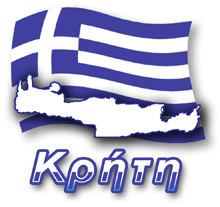

Agia Triada is a small Minoan archaeological site in the south of Crete, located near Timpaki, located on the western slope of the hill about 40 meters above sea level. To inquisitive tourists, the Christian name (Holy Trinity) of the Minoan position may seem at least strange, but this is only an expression of the ignorance of Italian archaeologists who were the first to discover this place. Not knowing what they found, they borrowed the name from a nearby abandoned village and gave it to excavations. The original name is still unknown. The first excavations were carried out at the beginning of the 19th century.
The Hagia Triada, as are sometimes called these ruins, is located a few kilometers from the famous palace of Phaistos , but unlike it, it is not that big or so old. The outdoor area is relatively small and only measures approximately 135 x 135 meters. The earliest traces of settlement in Agia Triada come from the end of the Neolithic period, the village grows over time and at the beginning of the Bronze Age there was already quite a large human place. Proof of this are the funeral rooms from this period and two graves, which according to the then customs were used for collective burials.

Agia Triada was also inhabited during the whole period of Mid-Merica (2000-1600 BC), unfortunately it is not known whether it played an important role then. Its importance grew only when around 1550 BC a so-called "royal villa" was created here. At the same time, at the time, the second palace in Fajstos was rebuilt on the ruins of the first one. The significance of the Villa was far smaller than its monumental neighbor, and in addition to the function it performed, many hypotheses arose. According to one of them, it was a summer residence for the prince of Phaistos or other high-ranking officials. Another version assumes that the villa belonged to an independent landowner. Apparently, this hypothesis is most likely.
It seems that the theory about the purpose of the villa as a summer residence for the ruler, does not find support in the findings themselves and the architectural layout of the ruins, which puts a big question mark about its destination.
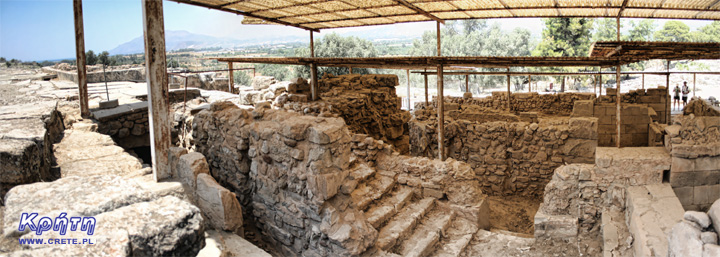
Could it actually be the summer residence? A large number of warehouses in relation to the total size of the villa, finding a large number of plates with the script and seals suggest, rather, that the building was mainly used for storing and recording agricultural products such as wheat, barley, figs, wine and oil. This doubt also appears in other so-called palaces. The not very functional and not very ergonomic arrangement of rooms rather excluded the use of some of these buildings as the seat of the ruler. Perhaps, therefore, the name "palaces" that Evans gave such buildings is not accurate, which was also questioned from the very beginning by historians and archaeologists.
What turned out to be surprising for Italian archaeologists working at Agia Triada are very rich finds (artifacts). A-letter plates, clay stamps for securing documents, wall paintings, stone carved vases, ritons, a famous sarcophagus showing funeral rites, 29-kilo pieces of bronze used in commercial transactions. In the city itself located north of the villa, the remains of an ancient city sewer, shops, houses from different periods were discovered. Agia Triada was not a building on the scale of Knossos or Fajstos , but nevertheless had apartments, skylights, chapels, warehouses, staircases, porticos and courtyards.
A very famous sarcophagus found in Agia Triada currently exhibited in the Archaeological Museum in Heraklion
The end of Agia Triada puts the same cataclysm which contributed to the collapse of the other Minoan centers in 1450 BC. The buildings were rebuilt only by the Mykene, putting Megaron, probably the seat of the Mycenaean ruler of the region and probably a sanctuary. However, these buildings were much smaller than those built by the Minoans.
In subsequent years, Agia Triada gets under the control of Venetians and Turks. The Turks contributed to the final destruction of the settlement in 1897, when they attacked the village and murdered all its inhabitants.
Agia Traida is located just 3 km from Fajstos so it is worth to use this neighborly location and combine sightseeing of both places, especially that combined tickets are offered, the cost of which is lower than for tickets purchased separately. When planning a tour you should keep in mind the short opening time of Agia Triada, because excavations can be visited only until 3 pm. A quiet and beautiful location among trees is an additional advantage, and for lovers of all kinds of excavations it may be tempting that Agia Triada is visited much less often than monumental neighbor in Fajstos. This is a guarantee that we will not encounter organized tours.
At the end, take a look at the Byzantine church of Agios Georgios located on a nearby hill. It comes from the Venetian period and was built in 1302. Inside the church there are pretty well preserved frescoes from the fourteenth century.
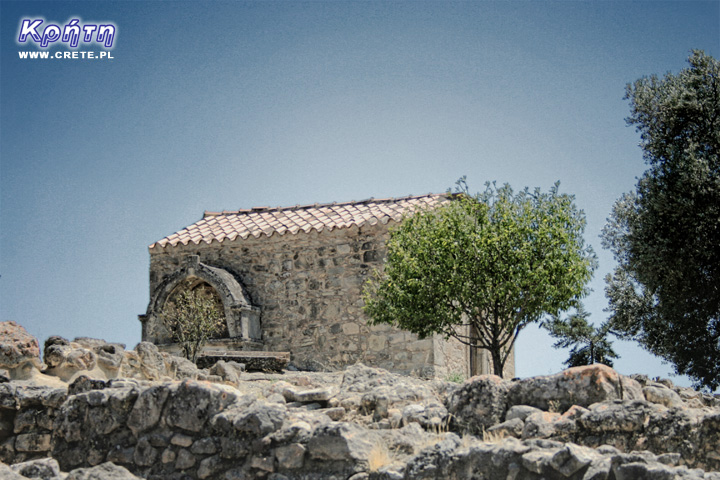
Coming from Heraklion , in the western part of the beltway, take the road number 97 leading towards the village of Agia Deka. When you reach this town, turn west and follow the roads around the town of Timbaki. Excavations are located a short distance from the excavations in Gortyn.
If your hotel is located in the western part of Crete, a better way of getting there will be the exit from the New National Road at the height of the city of Rethymnon . Wake up from the central exit of the beltway of this city, follow the national road number 97 leading towards Spili and Timabki. Guideposts for excavations should be looked at at the height of the village of Vori, located about 4.5 kilometers east of Timbaki.
You can leave your car in the parking lot located just off the road. On the excavation area you come down a fairly steep concrete stairs. The cost of tickets is 4 €.
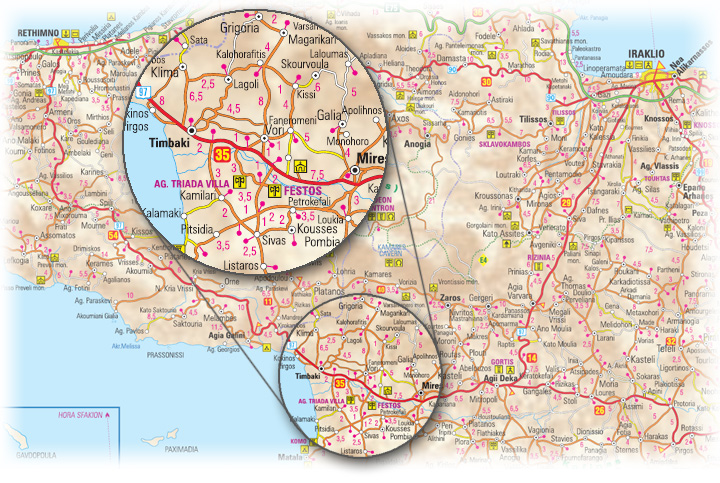
↤ click the appropriate part of the island to change the bottom map
Knossos is one of the flagship monuments visited by tourists, it is also the most popular place where organized trips go.
Heraklion (Iraklion) is the largest city of Crete. With almost 140,000 inhabitants, it is the fourth largest city in Greece.
Dozens of craft workshops located in this small mountain village make Margarites one of the four main centers where traditional Cretan ceramics are made.
International airport. Nikos Kazantzakis in Heraklion is currently the largest airport in Crete.
Heraklion (Iraklion) is the largest city of Crete. With almost 140,000 inhabitants, it is the fourth largest Greek city.
The date of the foundation of Moni Arkadiou (Arkadi) is not exactly known. According to tradition, the name of this church refers to the name of the Emperor Arkadiusz, who supposedly was to be its founder.
The date of the foundation of Moni Arkadiou (Arkadi) is not exactly known. According to tradition, the name of this church refers to the name of the Emperor Arkadiusz, who supposedly was to be its founder.
Rethymnon with around 40,000 inhabitants are the third largest city of Crete. This place was populated already in the Minoan period. Historically, the city was an important commercial center.
Thrapsano is a small town inhabited by slightly over 2,500 people, the vast majority of which until recently maintained their activity as a potter.
Skinaria is a small beach located along a small bay, whose outlet on both sides ends with a rocky coast. It is still a little-known place overlooked by mass tourism
Skinaria is a small beach located along a small bay, whose outlet on both sides ends with a rocky coast. It is still a little-known place overlooked by mass tourism
According to Greek mythology, Zeus hid (and perhaps even gave birth) in the Ida cave. This myth is the greatest asset of this cave, which is not as interesting and beautiful as the Dikte cave.
Tripiti is a small beach covered with a mixture of gray sand, gravel and stones. Despite the fact that the beach is unorganized and has a semi-natural appearance, one small tavern works here.
Tripiti is a small beach covered with a mixture of gray sand, gravel and stones. Despite the fact that the beach is unorganized and has a semi-natural appearance, one small tavern works here.
Tripiti is a small beach covered with a mixture of gray sand, gravel and stones. Despite the fact that the beach is unorganized and has a semi-natural appearance, one small tavern works here.
Plakias is a perfect place for people who like to spend time hiking. In the area of the town and the surrounding area, there are several hiking trails that lead to interesting beaches.
Currently, the lower monastery is still not open to the public and is not used by the monks. The buildings of the upper monastery have undergone partial renovation and are the main seat of the Preveli monastery.
Currently, the lower monastery is still not open to the public and is not used by the monks. The buildings of the upper monastery have undergone partial renovation and are the main seat of the Preveli monastery.
Currently, the lower monastery is still not open to the public and is not used by the monks. The buildings of the upper monastery have undergone partial renovation and are the main seat of the Preveli monastery.
The Kourtaliotiko Gorge, also known as the Asomatos Gorge, is perhaps one of the most spectacular natural attractions available in the central part of Crete.
Agia Triada is a small Minoan archaeological site in the south of Crete, located near Timpaki, located on the western slope of the hill about 40 meters above sea level.
Około 60 kilometrów na południowy zachód od stolicy Krety - Heraklionu znajdują się ruiny drugiego co do wielkości starożytnego pałacu - Fajstos.
Currently, Melidoni Cave (originally called Gerontospilios) is associated mainly with the tragic events that took place here in 1824.
This fortress is a perfect example of Crete's multiculturalism. Located today in Greek hands, it was built by the Venetians, but is called a name taken from the Turkish language.
It is one of the most important and largest museums in Greece and one of the most important in Europe.
Tylissos is one of the few places in Crete that has kept its name since ancient times.
Plaża w Damnoni jest położona po sąsiedzku z Plakias - popularną turystyczną miejscowością
Agios Pavlos is a small town located on the southern coast of Crete near Saktouria.
Triopetra is located at the foot of the Siderotas mountain about 52 km south of Rethymno.
gia Galini (Αγία Γαλήνη) jest jednym z najpopularniejszych nadmorskich kurortów na południowym wybrzeżu Krety.
The observatory is located at the top of the Skinakas mountain at an altitude of 1750 m. The idea for its construction was born in 1984.
The Late-Romanesque cemetery in Armeni is located on the outskirts of this town, located less than 10 km south of the center of Rethymno.
The museum presents the dramatic history of Crete written over the last several hundred years.
The modern settlement known as Argyroupolis was built on the site of the ancient city of Lappa (also called Lambi)
Lentas is a good idea for those who want to get away from villages steeped in industrial tourism.
This ancient quarry, consisting of two parts by modern times, is called Λαβυρινθάκι and Λαβύρινθος.
If anyone of you is looking for a good restaurant near Matala and Kalamaki, then we would like to recommend estiório Chrisopigi.
Psiloritis (Timios Stavros - Holy Cross) is the top of the highest mountain of Crete, rising to 2456 m above sea level.
Rouvas Gorge is one of the most interesting places in this part of Crete. The interesting trail leads in a perfect way to the changing appearance of this gorge.
Matala is one of the most popular towns not only of the southern coast but also of the whole of Crete. In the 1960s and 1970s, this small fishing village was a mecca for hippies.
The Odigitrias Monastery is one of the most famous monasteries of southern Crete. Unfortunately, in terms of popularity, he is far from other Cretan monasteries.
Kali Limenes (meaning Dobre Porty or Piękny Przystanie) is a coastal town located in the Asterousia Mountains on the southern coast of Crete.
In addition to the famous grand palaces on the island in the Minoan period, a number of smaller residences were created. One of the most important examples is the Vathipetro discovered about 5 km north of Archanes, on the southeastern slope of Mount Juchtas in the central part of Crete.
When traveling around Crete, it is not difficult to pay attention to the fact that most of the beaches there are relatively small and short. For this reason, people who are used to our national Baltic standards, where the sandy coast stretches for kilometers, may experience a special disappointment. However, fortunately, nothing is lost, because Crete in its rich arsenal of various beaches can boast of those that allow for long walks along the coast. One of them, our favorite is the Kommos beach located in the south of the central part of the island.
Although there are countless caves in Crete, only a few can be visited. Sfendoni is the largest cave open to the public. content comes from: http://www.crete.pl www.CRETE.pl
The old Venetian port and the lighthouse are one of the most recognizable elements of Rethymno.
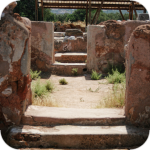
The first Palace was built around 1900 BC in the place where there was a quite impressive settlement, whose remains were later transformed into the central part of the city. Very little is known about this palace, although some fragments of the floors and its walls have been preserved and encountered during works carried out in the younger buildings. This palace survived until 1700 BC when it was destroyed, and in its place the Second Palace was built, in many respects similar to the first one. It is its ruins that you can admire today, its end was laid in 1450 BC, when all the Minoan centers in Crete were destroyed.
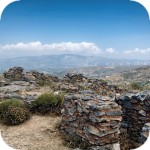
11 km from the city of Sitia, near the modern village of Chamaizi, there is a small archaeological site. At the top of a cone-shaped hill called Souvloto Mouri, the remains of an unusual building with a unique oval shape were discovered. Despite its small size, it is one of the most important discoveries that comes from the Central Minoan period. So far, it is the only oval building from Crete in this period.
Redirected from the site - Káto Zákros (Ζάκρος). Zakros is the fourth-largest Minoan palace in Crete in importance and size. This latest found, built on the east coast of the island is located in the village of Káto Zákros. Rocky mountains surround the ruins of the palace complex with the remains of a once thriving city, built on a fairly hard-to-reach and inhabited area. Paradoxically, Zakros, being several centuries ago, a city with extensive contacts with other countries, was (and is actually still) the most isolated Minoan center on the island.
Komentarze
Wypełnij poniższy formularz aby dodać komentarz